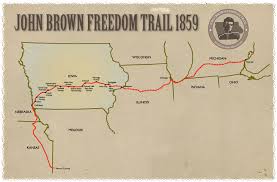Winter and the Underground Railroad
Adair County, Iowa
Beck O’Brien
1850s
In the late 1850s, a man named John Brown aided people escaping from slavery on the underground railroad as he traveled from western to eastern Iowa. Brown was raised “in the family tradition of opposition to slavery” in Ohio. In 1855 he moved to Kansas, following his sons, to become “active in the guerilla warfare over the slavery issue.” At one time, after Brown raided Missouri, taking with him twelve enslaved people whom he hoped to usher into freedom in Canada, the President of the United States offered a reward for his capture.
The underground railroad went directly through Adair County. One wintry night, Brown knocked on the station entrance that was the door to Azariah Root’s home. According to Azariah’s son, Abner Root, it was a “cold mid-winter evening….There was just enough snow on the ground to make good sledding” when John Brown arrived, seven people running away close behind. Brown instructed Azariah as to where to take the seven refugees, then rode into the night.
As Azariah prepared the sled, Abner’s mother “took the cold and hungry Negroes into the kitchen and gave them some hot food and coffee. The sled once ready the Negroes were deposited in the bottom in a prone position and then covered with heavy blankets, for fear someone would see them while en route to our destination.” That evening those seven people fleeing slavery safely traveled 36 “snow-covered” miles to the next station at Winterset.
But not every wintertime trip in Adair county Iowa was quite so successful.
In an incident not involving the Underground Railroad, around Christmas 1859, Daniel Imus and his brother were en route to Eureka township from Audubon County. The brothers left Morisson’s Grove (present-day Anita) in Cass county around noon.
“The snow was knee deep when they started, and while on their way, another storm came on. They struggled on manfully for a time, but the cold and storm soon benumbed their faculties. Daniel tried to encourage his brother to a renewed effort, but in spite of all the younger man gave up and was soon wrapped in a shroud of snow.”
Daniel continued on hopefully to find help for his brother, but “he, too, gave up to the over-powering stupor that precedes the act of freezing and laid down, and was soon wrapped in the sleep that knows no waking.”
Surely freezing to death must have also been an issue on the Underground Railroad, since some numbers of people fleeing slavery traveled to freedom in the winter time. In one incident, the freezing of a river aided anti-abolitionists in their pursuit of two runaway women. The women were already very close to Lewis, Iowa when the Missouri River froze, allowing seventy-five armed Nebraskans to cross the river, overtake a group of abolitionists, and free two anti-abolitionists held hostage. However, they did not come upon the two runaway women, even when their former owner traveled to Lewis suspecting they were there. At that time, they were quickly on their way towards Adair, which at the time was known as “Quaker Divide.” Eventually, they made it to Chicago.

